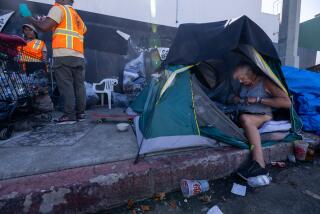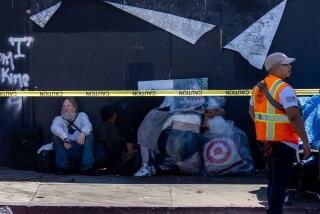Cold Reception
- Share via
Just about the only thing longer than the lines of families shivering in 20- degree temperatures as they try to enter Los Angeles-area shelters is the list of unfulfilled promises that city, state and national leaders have made to “end homelessness.”
In Los Angeles County, the problem is getting worse. It is notoriously hard to get reliable numbers on people living on the streets, but the Institute for the Study of Homelessness and Poverty in Los Angeles puts the figure at 83,000, about double what it was in 1994.
With shelters jammed to capacity, local officials point a finger at the federal government, which supplies the vast majority of funding for such services. But there’s enough blame to go around.
Local civic leaders have stoked, or at least failed to discourage, “not in my back yard” resistance to even small-scale transitional housing. The Santa Clarita City Council punted last week when it decided not to reopen its winter shelter. Instead, the council agreed to pay $36,000 to have a nonprofit group bus the unhoused to shelters in the San Fernando Valley and downtown Los Angeles. About $2 million in federal funds for shelter and services, meanwhile, goes unspent across the county because local officials refuse to provide any sites.
At the state level, legislators have too broadly interpreted Proposition 46, a 2002 bond measure allocating $2.1 billion to build housing and otherwise pay for shelter for low-income people. Since then, the definition of “low income” has been stretched to include teachers, who are getting help with mortgages on townhomes. Earlier this year, some legislators discussed raiding the measure’s funds to help offset the budget deficit.
And yes, the federal government bears a large portion of blame. These days it seems hard to believe but, before 9/11, President Bush was as passionate about fighting for shelter and assistance as he now is about the war in Iraq, vowing strong measures with his Samaritan initiative. On Nov. 19, Congress cut federal homeless funding by $378 million, a 4% reduction from 2004. The Iraq war, meanwhile, will require expenditures of at least $4.8 billion a month in the coming year, according to Government Accountability Office estimates.
The administration also resists using Housing and Urban Development dollars for counseling, drug rehabilitation and other programs that keep people off the streets for the long term. Last year, HUD officials barred the Los Angeles Homeless Services Authority, a city-county agency, from spending more than 15% of its $100 million in federal aid on these needed services.
Change is needed at every level, but it should include a civic effort to show that shelters need not be magnets luring drug-addicted skid row drifters. Most neighborhood shelters these days provide multiple services under one roof and have tough rules for “clients,” who increasingly tend to be families unable to afford L.A.’s high-priced housing. Busing them elsewhere won’t solve the problem.
More to Read
Sign up for Essential California
The most important California stories and recommendations in your inbox every morning.
You may occasionally receive promotional content from the Los Angeles Times.










